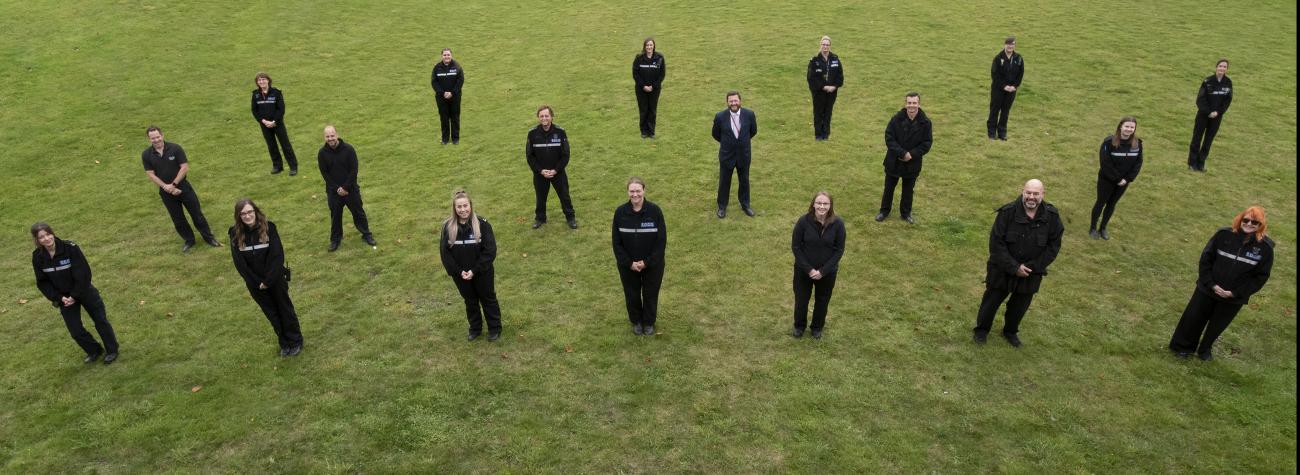
In October, Bedfordshire, Cambridgeshire and Hertfordshire Police (BCH) became the first forces to gain accreditation for volume crime scene examination from UKAS.
Bedfordshire Police is the legal entity which delivers forensic services to all three forces and is now accredited to ISO/IEC 17020 for activities at the Hatfield site, in Hertfordshire. The three-force collaboration has five other Scenes of Crime offices which will be assessed throughout 2021.
We spoke with the senior leadership team of the collaboration’s Scientific Services Unit responsible for delivery across Scenes of Crime. They kindly shared insights for other forces and regions on what it takes to gain accreditation.

Embracing culture change
The accreditation process is hugely technical, requiring forensic units to show their impartiality, competence and suitable methods, processes and equipment. It’s interesting, then, that the main insight from BCH’s team is on mindset and culture change. The team’s focus throughout the path to accreditation was to ensure all staff owned the change, rather than feeling it was being done to them.
“It takes significant cultural change to deliver what we've delivered, and mindset and buy-in from staff,” says Michael Hanlon, Portfolio Lead for Crime Scene Examination. “Rather than writing-off a centralised group to deliver it, we made a conscious decision to engage as many practitioners as we could and spread jobs as equally as possible. It wasn’t a case of five people written-off for two years. Involving everybody is key.
“The Regulator says forces should expect a 20-30% uplift in work to secure accreditation, and of course people see this coming on top of work they've already been doing year after year, so it can feel frustrating. But from the outset we didn’t want our people seeing it as bureaucracy, something cumbersome and unnecessary. It isn’t a tick-box exercise. ISO accreditation doesn’t come on top of the day job: these ways of working are the day job.”
Two years of change
When it comes to the technical steps required to become ready for assessment, Mark Watson, Forensic Manager and 17020 Technical Lead, explains the steps taken and the importance of adapting the strategy as it was progressed.
“The first job was developing standard operating procedures, or SOPs, which was what we were technically going to do,” Mark says. This involved assigning various Principal Scenes of Crime Officers (SOCOs) to develop each SOP, and a nominee from each force to work with the lead author. SOPs were consulted on with all staff, giving them an opportunity to input into the processes, before procedures were agreed and issued.
The next step was the most significant: validation.
“This means proving the technical activities in our SOPs actually worked,” Mark says. “Essentially, we were undertaking scientific experimental activity to quality assure our processes. It is such a huge amount of work that it needs to be distributed into the team. In the end, we had a third of our workforce engaged in some aspect of validation over a nine-month period.
“We also had to ensure everyone was competent in validation. It was a big piece of work which took around a year. There are so many technical activities, anything from using fingerprint powders and then lifting or photographing prints, to casting footprints from soil. Overall, there were 21 different areas we had to assess for all 90 people.”
Rethinking ISO
Looking closer into the Hatfield site which was granted accreditation, Stuart York, the office’s Principal SOCO, sets out the pragmatic ways his team achieved the impressive accreditation milestone. Stuart is supported by two Supervisors who are directly responsible for a team of 20 people, the majority of whom work on volume crime scenes.
Complementing the views of Michael and Mark, Stuart emphasises how much of a team effort the project was.
“The whole thing is centred around lots of teamwork and communicating with each other,” he says. “The Supervisors understood what we were trying to achieve and over the last couple of years have involved the whole team to help them understand it too. It’s human nature that you enjoy the job more if you own your piece of work, so we gave individuals in the office specific pieces of work.”
It is also vital for the senior management team to be flexible, open to feedback and be acutely aware of the pressures on their teams.
“We had to listen carefully to feedback when trying to put things into practice. It’s about getting our people at a technical level to interpret things discussed at a higher level. We are always looking for them to come up with new ideas, as they're at the coalface and testing the processes: if anyone will come up with ideas, it's them.”
There are also some small nuances in language, which can be surprisingly effective in making big changes in people’s mindset.
Stuart says: “Everything ISO does is about quality. What worked well was getting away from the term ISO itself, and calling it quality instead, because quality is at the heart of what we do. For example, if someone questions a technique, we ask ‘how does it affect the quality of work you produce?’ ”
Assessments
By the time UKAS visited the site, the team had developed an impressive positive attitude towards quality, and understood the importance of delivering a product fit for the Criminal Justice System.
Stuart says: “What Assessors appreciated was that we didn’t take shortcuts. A lot of processes now take longer but give the organisation better reassurance that the right evidence is being provided. The quest is professionalising our occupation. When we record errors, it isn’t about catching people out, it’s done in the quest for quality.”
How did the team keep up morale during the long and sometimes frustrating path to accreditation?
Portfolio Lead, Michael, says: “Having one office to focus people’s attention on really helped. If another office in any of the forces are feeling down, we remind them what Hatfield have achieved and we can show them that they will achieve it too. It’s about reassuring practitioners of their efforts: we’ve conquered most of the mountain already.”
Stuart adds: “Nothing happened overnight, we plugged away. We’re blessed with a very good team who accepted far more change than we could have hoped for, so we can't take credit for it.”
With Hatfield accredited and the team confident in its quality management system, the BCH Scientific Services Unit aims to have its Stevenage, Cambridge, Peterborough, Luton and Kempston offices assessed throughout 2021. And even after volume crime is accredited, the team has more plates to spin as it brings serious and major crime into scope in the coming years.
The last word
We also heard from Stuart Brennan, Head of Scientific Services at Beds, Cambs and Herts Police, who oversaw the activity and spoke in praise of his team’s achievements.
“The delivery of 17020 within the Hatfield office was a real team effort, from those managing the change to those delivering the change and then subsequently to those embedding the new ways of working,” Stuart says. “Those involved are all exemplars in terms of their attitudes and professionalism. Without their proactive approach and engagement, it just wouldn’t have been possible.”
About this article
Force Focus is a series of in-depth articles with people across the FCN membership, sharing insights and ideas from one force to others. If you’d like to share a story from your organisation for a future Force Focus, please contact us.